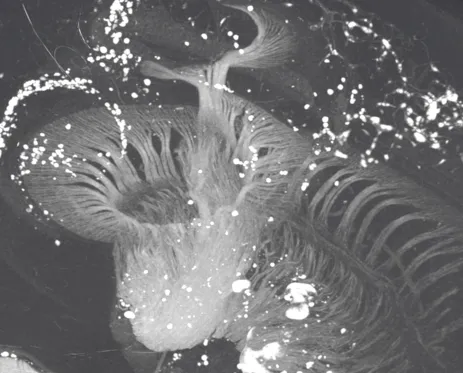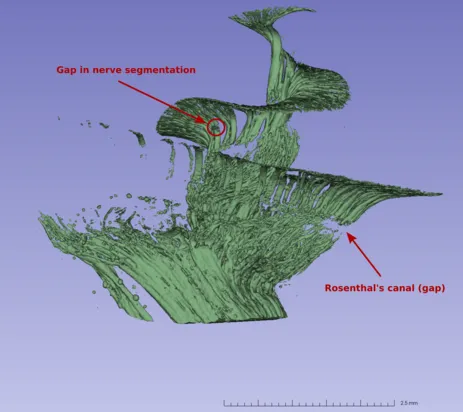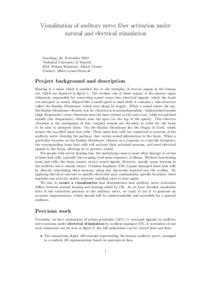Research Internship
Nerve + Rosenthal's Canal Segmentation


Current status 04.2025: 10/17 segmentations available
In cooperation with the Medical University of Innsbruck, we obtained new, high-resolution scans of the human inner ear, scanned in the MuCLS. The scans have a voxel-resolution of 6 µm, and good visibility on the auditory nerve (left figure).
The scans are required for improvements in models of the human cochlea, especially in regard to electrical stimulation by cochlear implants. To make use of the scans in the models, however, first a segmentation of the relevant structures is necessary. We already have semi-automatic segmentations of the auditory nerve (right figure).
The task of the project is the finalization of the current nerve segmentation. Two aspects are especially relevant:
- Fixing small gaps in the nerve segmentation, caused by artifacts in the original scans.
- Segmentation of the Rosenthal's Canal, the structure containing the cell bodies of the neurons in the auditory nerve. The canal is visible as a gap in the current segmentation.
In addition, the morphology of the segmented structures is to be measured and interpreted.
Prior knowledge about the anatomy and functionality of the inner ear and neurons is desired, but not required. For this, a visit of the lectures Neuroprosthetics or Systemtheorie der Sinnesorgane is advantageous. The segmentation will be done on Dragonfly, experience in the program is advantageous, but not required.
If you are interested, write to albert.croner@tum.de, including your current transcript of records and CV.
Inter-disciplinary Project
Visualization of the activation of the auditory nerve
We have models of the human inner ear, including neurons of the attached auditory nerve. From these models, we obtain the activation patterns of the auditory nerve, if it is activated by electrical stimulation, i.e. by a cochlear implant (CI). The activation patterns are to be visualized, to allow for easier understanding of the workings of the human inner ear, as well as of cochlear implants.
We already have initial animations of the auditory nerve activation (in slowed representation), but there are still more projects available:
- Integration of the neuron animations into a video sequence showing surrounding morphology (head, inner ear).
- Improvement of the existing Visualization (electric stimulation)
- Visualization of the auditory nerve activation for a healthy ear (acoustic stimulation)
- Visualization of the auditory nerve activation in real-time speed (electric and acoustic stimulation)
- Improvement of an existing VR environment of the human cochlea and the auditory nerve activation
The projects are available for all master studies which require inter-disciplinary projects. If you are interested, please write to albert.croner@tum.de, including your grade report and CV.
For more details, see the attached PDF.
